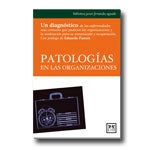The world of management now has its own corporate ready reference manual. Organizational Pathologies, published by LID Editorial, outlines 41 different organizational illnesses and for each case, provides a complete diagnosis and suggests proper treatments. In preparation for their work, Javier Fernández Aguado, a Spanish business theoretician; Marcos Urarte, president of the Pharos strategic consulting firm; and Francisco Alcalde, author of Who’s Who in Spanish Management, consulted a dozen medical doctors who helped them use the proper terminology.

Sign up to stay informed about our latest article releases.